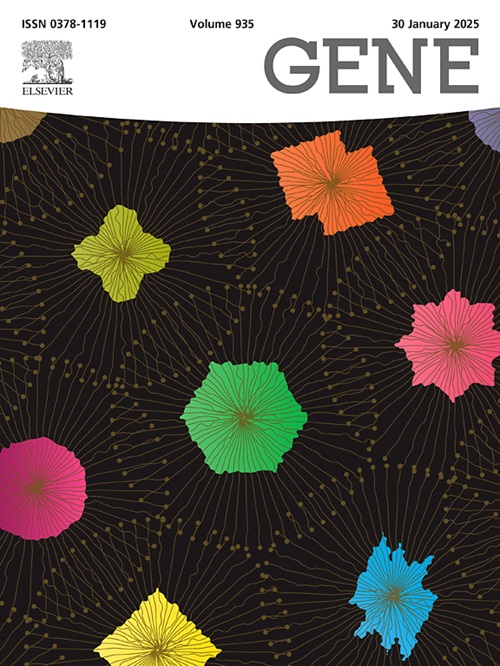Whole genome re-sequencing reveals high altitude adaptation signatures and admixture in Ladakhi cattle
IF 2.6
3区 生物学
Q2 GENETICS & HEREDITY
引用次数: 0
Abstract
Ladakhi cattle, native to the high-altitude region of Ladakh in northern India (ranging from 3,000 to 5,000 m above sea level), have evolved unique genetic adaptations to thrive in harsh environmental conditions, such as hypoxia, extreme cold, and low humidity. This study explored the genome of Ladakhi cattle to investigate genetic structure, selection signatures, and adaptive mechanisms. Whole genome sequencing reads, generated on Illumina NovaSeq 6000 platform, were aligned to the Bos taurus reference genome with BWA-MEM. SNPs were identified and filtered using GATK and bcftools, and functionally annotated with SnpEff. For population genomic analysis, PCA and admixture modeling assessed genetic structure, while Neighbor-Joining trees, LD decay, nucleotide diversity (π), and FST evaluated phylogenetic relationships and genetic variation. Selective sweeps were detected using RAiSD, and gene-set enrichment and protein–protein interaction analyses were conducted to explore functional pathways related to adaptation. The study revealed 3,759,279 unique SNPs and demonstrated that Ladakhi cattle form a distinct genetic cluster with an estimated admixture of 68 % Bos indicus and 32 % Bos taurus ancestry. Key findings include rapid linkage disequilibrium decay, low inbreeding level, and the identification of selection signatures and genes associated with hypoxia response, energy metabolism, and cold adaptation. Mean nucleotide diversity (π, 0.0037) and FST values indicated moderate genetic differentiation from other breeds. The analysis highlighted selection signatures for genes like HIF1A, ENO4, ANGPT1, EPO, NOS3, MAPK3, HMOX1, BCL2, CAMK2D, MTOR, AKT2, PIK3CB, and MAP2K1, among others, including various keratin and heat shock proteins. The interaction between genes associated with hypoxia signaling (HIF-1) and other enriched pathways such as PI3K, mTOR, NFκB, ERK, and ER stress, reveals a complex mechanism for managing hypoxic stress in Ladakhi cattle. These findings offer valuable insights for breeding programs aimed at enhancing livestock resilience in extreme environments and enhance understanding of mammalian adaptation to high-altitude conditions.
全基因组重测序揭示了拉达克牛的高海拔适应特征和掺杂现象。
拉达克牛原产于印度北部的拉达克高海拔地区(海拔 3,000 至 5,000 米),它们进化出了独特的遗传适应性,能够在缺氧、极寒和低湿度等恶劣环境条件下茁壮成长。这项研究探索了拉达克牛的基因组,以研究遗传结构、选择特征和适应机制。在 Illumina NovaSeq 6000 平台上生成的全基因组测序读数通过 BWA-MEM 与金牛参考基因组进行了比对。使用 GATK 和 bcftools 对 SNPs 进行鉴定和筛选,并使用 SnpEff 进行功能注释。在种群基因组分析中,PCA和掺杂模型评估了遗传结构,而邻接树、LD衰减、核苷酸多样性(π)和FST评估了系统发生关系和遗传变异。利用 RAiSD 检测了选择性扫描,并进行了基因组富集和蛋白质相互作用分析,以探索与适应有关的功能途径。研究发现了 3,759,279 个独特的 SNPs,并证明拉达克牛形成了一个独特的遗传集群,其祖先中估计有 68% 的 Bos indicus 牛和 32% 的 Bos taurus 牛。主要发现包括快速的连锁不平衡衰减、低近交水平以及与缺氧反应、能量代谢和寒冷适应相关的选择特征和基因的鉴定。平均核苷酸多样性(π,0.0037)和 FST 值表明与其他品种的遗传差异不大。分析凸显了 HIF1A、ENO4、ANGPT1、EPO、NOS3、MAPK3、HMOX1、BCL2、CAMK2D、MTOR、AKT2、PIK3CB 和 MAP2K1 等基因的选择特征,包括各种角蛋白和热休克蛋白。缺氧信号转导相关基因(HIF-1)与 PI3K、mTOR、NFκB、ERK 和 ER 应激等其他丰富通路之间的相互作用揭示了拉达克牛缺氧应激管理的复杂机制。这些发现为旨在提高牲畜在极端环境中的适应能力的育种计划提供了宝贵的见解,并加深了人们对哺乳动物适应高海拔条件的理解。
本文章由计算机程序翻译,如有差异,请以英文原文为准。
求助全文
约1分钟内获得全文
求助全文
来源期刊

Gene
生物-遗传学
CiteScore
6.10
自引率
2.90%
发文量
718
审稿时长
42 days
期刊介绍:
Gene publishes papers that focus on the regulation, expression, function and evolution of genes in all biological contexts, including all prokaryotic and eukaryotic organisms, as well as viruses.
 求助内容:
求助内容: 应助结果提醒方式:
应助结果提醒方式:


